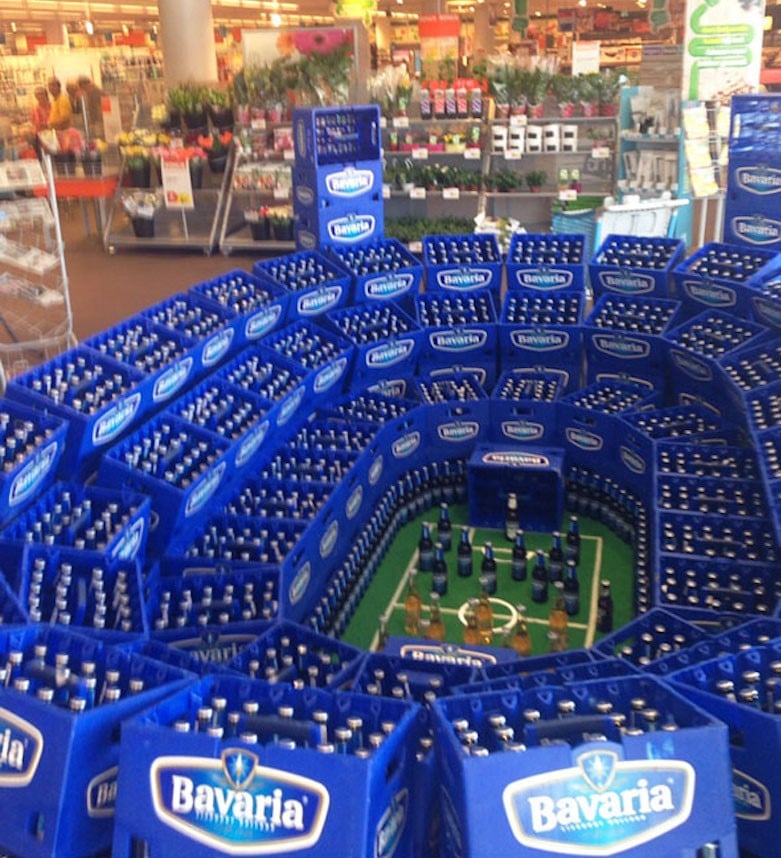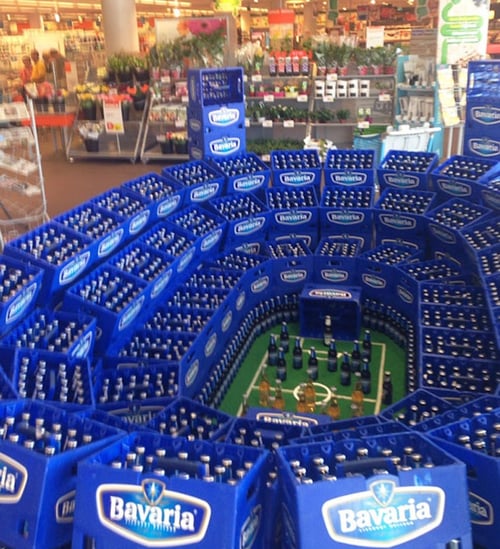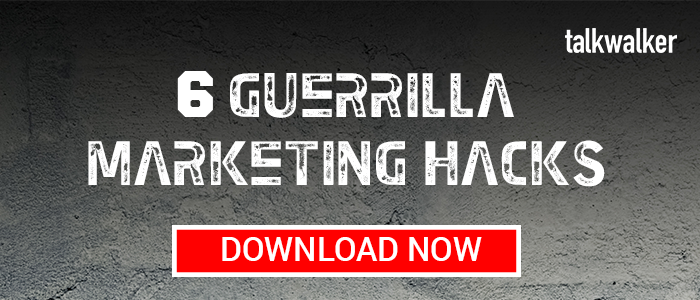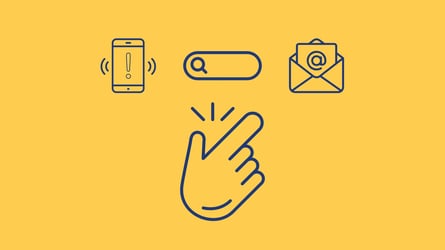Download your Guerrilla Marketing Guide
So, I said it had nothing to do with warfare...
Well, in fact, the term does stem from the irregular tactics practiced in guerrilla warfare - such as ambush and sabotage - and first appeared in the 1984 Jay Conrad Levinson book “Guerrilla Advertising”.
But, in a marketing sense, it’s really about using the element of surprise to create unique and impactful campaigns.
As such, guerrilla marketing is often a great excuse to truly unload your creative juices and think outside the box.
The aim is to create as much of a buzz as possible, with the ultimate ambition of having people celebrate your creativity and innovation - while going viral, of course.
How is guerrilla marketing any different from other strategies?
Initially, guerrilla marketing was a way for smaller companies to compensate for a lack of big budget by developing innovative ideas. The logic being that there was no way to compete with bigger brands simply by copying their approach on a shoestring budget.
However, as with all good ideas, bigger brands soon decided that they too should reap the benefits and so guerrilla marketing became somewhat of a free for all.
Despite this, it’s certainly not necessarily the case that the more you spend the greater the rewards you’ll reap. There are numerous examples of budget campaigns that have made a huge impact - such as this great example of Bavaria's beer crate and bottle football pitch.
Image via Reddit
So, where should you start?
There are multiple variations of guerrilla marketing - from stealth to ambush and ambient to astroturf - you can read more about them in this post about the types of Guerrilla marketing.
They do all tend to have one thing in common, however, in that they transcend the archetypal marketing mediums and opportunistically intercept their target audience during their day-to-day.
In a way, you could consider this approach to be the pop-up ad of the physical world. This comparison does, however, somewhat overlook the integrity, uniqueness and creativity involved in guerrilla marketing.
Whereas digital advertising is predominantly about utilising data and algorithms to place adverts in the most rational and obvious positions, guerrilla marketing tends to focus more on identifying unusual platforms and positions through which to deliver a more unique and memorable style of messaging.
Even when the positioning itself is not unusual - a billboard, for example, is a common traditional platform for such campaigns - the execution would need to be unique and innovative in order for an ad to be considered “guerrilla” in nature.
In short, innovation with regards positioning or execution is really an essential ingredient of any guerrilla marketing strategy and is thus the logical place to start.
And what about the end goal?
As with any good marketing campaign, it is crucial to set concrete KPIs from the get-go.
Although guerrilla marketing tends to focus on buzz - and therefore brand awareness - campaigns can also help to educate, activate an untapped demographic and even directly generate new business.
Beyond this, a successful guerrilla marketing campaign also helps to champion your brand’s innovation and creative spirit - which is never a bad thing.
But, if we are to start with the ultimate ambition of going viral, it’s imperative that your guerrilla marketing campaign is viral-primed. In other words, it’s great if people enjoy the ad and it draws a positive response, but how can you ensure that this helps to propel the campaign to a wider audience?
By integrating a “share catalyst” within your campaign, you can help to enhance the natural word of mouth diffusion to maximize reach.
It’s also very common for brands to activate the social buzz surrounding guerrilla marketing campaign themselves, with reaction videos a common tactic.
Let’s take a look at a few great examples of guerrilla marketing
As mentioned at the beginning of the article, for a more detailed look at 6 of the best guerrilla marketing campaigns from the past 6 months, you can download our new Guerrilla Marketing Guide.
This 14-page downloadable PDF includes examples from IKEA, Coca-Cola, Lush, Swiggy, Carlsberg and The North Face, and covers all 6 guerrilla marketing approaches.
For now though, let’s take a deep dive into one of my personal favourites:
Carlsberg: Probably NOT the best beer in the world
Firstly, what made Carlsberg’s campaign so great, in my opinion, was the throughstory. They were able to seamlessly integrate several strategy components together to not only create an initial buzz, but also to build on this to achieve sustained intrigue.
What started out as promoted social posts, soon spread to online video and later print, billboard and TV ads.
So, let’s take a closer look.
Creating the initial intrigue
The first step for this campaign was the promotion of posts insulting Carlsberg and, in particular, its longstanding claim to be “probably the world’s best beer”.

And it wasn’t long before people started to take notice - with commenters both on social media...

...and within other online publications:
From an article published in The Drum on 11 April 2019
People were quick to cotton on to the fact that, though initially seeming rather bizarre, these promoted Tweets were quite clearly the start of a wider campaign.
This is a great example of how guerrilla marketing can be used as a launchpad for a more mainstream campaign - though the guerrilla tactics didn’t end there.
Following up with a mock “mean Tweets” video
It wasn’t long before these suspicions were confirmed, when Carlsberg followed up the promoted Tweets with a video of employees reading them out and reacting to them.
These videos then announced that they were launching a new rebrewed Pilsner.
Taking it mainstream
The campaign was then concluded with a more traditional product launch via billboards…
Photo: Tennent’s
...digital ads…

Photo: Carlsberg UK
...and now a TV advert:
Measuring the impact
As is probably already quite apparent from the fact that Carlsberg decided to take the campaign from digital channels to TV, the campaign has been a success.
Indeed, according to Lynsey Woods, Carlsberg UK’s director of marketing - “...it’s exceeded our expectations in terms of the sheer amount of conversation that it has driven among consumers.”
Both in terms of ad awareness and consumer consideration, the impact was also positive - with a 9.7% and 3.1 point increase, respectively, according to the YouGov BrandIndex.
By analyzing #newbrew for the months after the April 10 activation on QuickSearch, we can see a high level of mentions and engagement - at 5.9k and 16.4k, respectively.

#newbrew mentions: 10th April to 21st June 2019
The mentions clearly grew to a peak in the days following the initial activation, prior to hitting a second peak on April 29 - when Carlsberg UK officially announced the launch of the new pilsner:
The fact that the level of mentions continued at a decent volume until the end of May is a clear sign of Carlsberg’s success in not only creating intrigue, but also being able to maintain interest in the campaign for close to two months.
A quick look at the sentiment attached to the campaign backs this up further:

Analysis of sentiment: 10th April to 21st June 2019
The interesting thing here is that you can clearly see the high level of negative sentiment related to the initial promoted posts. But, since then, sentiment has been maintained at very positive levels.
Go guerrilla marketing!
So, what are you waiting for?
Take a look at 5 further examples of great guerrilla marketing campaigns form the past 6 months and then get started on your own.





